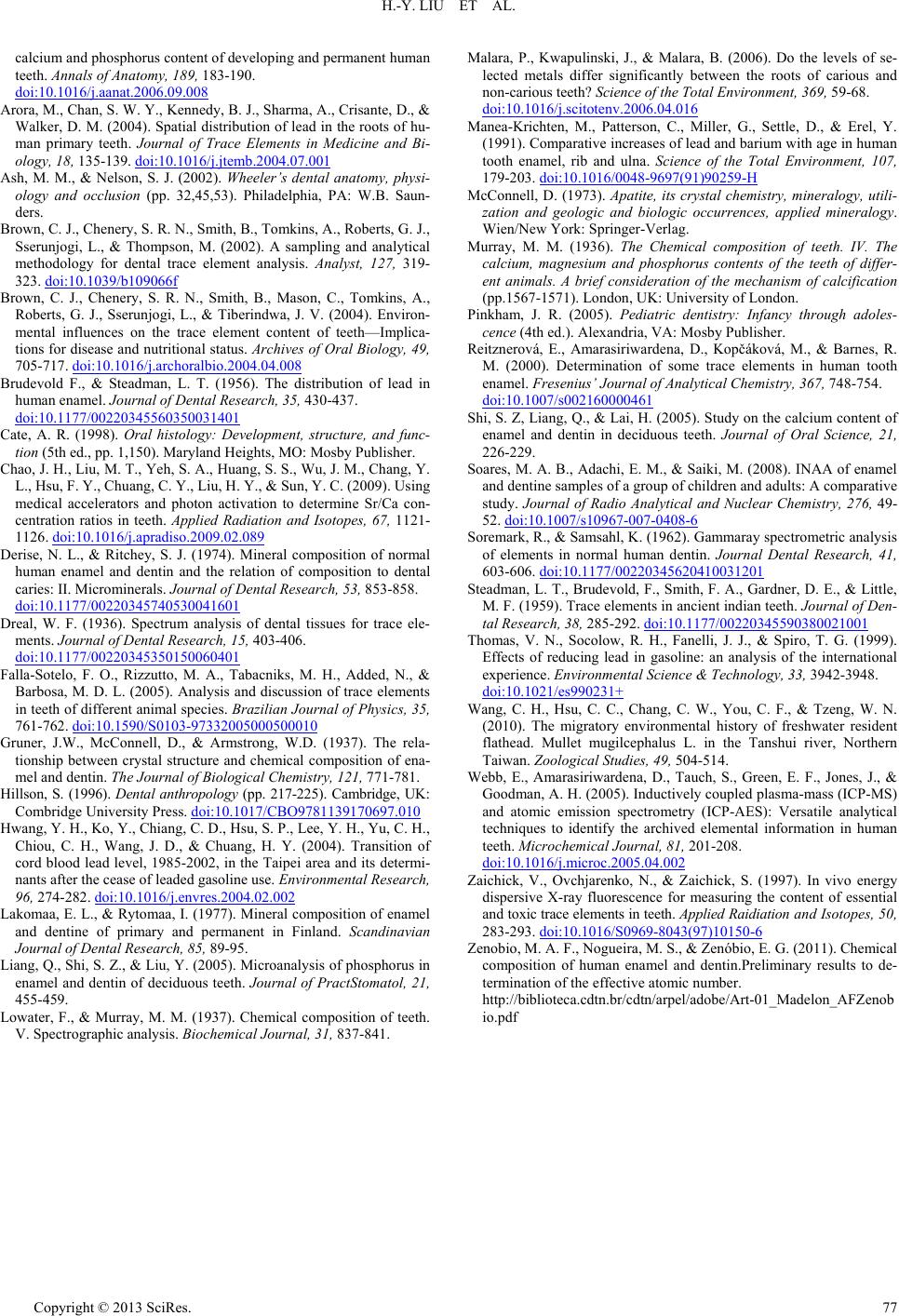
H.-Y. LIU ET AL.
Copyright © 2013 SciRes. 77
calcium and phosphorus content of developing and permanent human
teeth. Annals of Anatomy, 189, 183-190.
doi:10.1016/j.aanat.2006.09.008
Arora, M., Chan, S. W. Y., Kennedy, B. J., Sharma, A., Crisante, D., &
Walker, D. M. (2004). Spatial distribution of lead in the roots of hu-
man primary teeth. Journal of Trace Elements in Medicine and Bi-
ology, 18, 135-139. doi:10.1016/j.jtemb.2004.07.001
Ash, M. M., & Nelson, S. J. (2002). Wheeler’s dental anatomy, physi-
ology and occlusion (pp. 32,45,53). Philadelphia, PA: W.B. Saun-
ders.
Brown, C. J., Chenery, S. R. N., Smith, B., Tomkins, A., Roberts, G. J.,
Sserunjogi, L., & Thompson, M. (2002). A sampling and analytical
methodology for dental trace element analysis. Analyst, 127, 319-
323. doi:10.1039/b109066f
Brown, C. J., Chenery, S. R. N., Smith, B., Mason, C., Tomkins, A.,
Roberts, G. J., Sserunjogi, L., & Tiberindwa, J. V. (2004). Environ-
mental influences on the trace element content of teeth—Implica-
tions for disease and nutritional status. Archives of Oral Biology, 49,
705-717. doi:10.1016/j.archoralbio.2004.04.008
Brudevold F., & Steadman, L. T. (1956). The distribution of lead in
human enamel. Journal of Dental Research, 35, 430-437.
doi:10.1177/00220345560350031401
Cate, A. R. (1998). Oral histology: Development, structure, and func-
tion (5th ed., pp. 1,150). Maryland Heights, MO: Mosby Publisher.
Chao, J. H., Liu, M. T., Yeh, S. A., Huang, S. S., Wu, J. M., Chang, Y.
L., Hsu, F. Y., Chuang, C. Y., Liu, H. Y., & Sun, Y. C. (2009). Using
medical accelerators and photon activation to determine Sr/Ca con-
centration ratios in teeth. Applied Radiation and Isotopes, 67, 1121-
1126. doi:10.1016/j.apradiso.2009.02.089
Derise, N. L., & Ritchey, S. J. (1974). Mineral composition of normal
human enamel and dentin and the relation of composition to dental
caries: II. Microminerals. Journal of Dental Research, 53, 853-858.
doi:10.1177/00220345740530041601
Dreal, W. F. (1936). Spectrum analysis of dental tissues for trace ele-
ments. Journal of Dental Research, 15, 403-406.
doi:10.1177/00220345350150060401
Falla-Sotelo, F. O., Rizzutto, M. A., Tabacniks, M. H., Added, N., &
Barbosa, M. D. L. (2005). Analysis and discussion of trace elements
in teeth of different animal species. Brazilian Journal of Physics, 35,
761-762. doi:10.1590/S0103-97332005000500010
Gruner, J.W., McConnell, D., & Armstrong, W.D. (1937). The rela-
tionship between crystal structure and chemical composition of ena-
mel and dentin. The Journal of Biological Chemistry, 121, 771-781.
Hillson, S. (1996). Dental anthropology (pp. 217-225). Cambridge, UK:
Combridge University Press. doi:10.1017/CBO9781139170697.010
Hwang, Y. H., Ko, Y., Chiang, C. D., Hsu, S. P., Lee, Y. H., Yu, C. H.,
Chiou, C. H., Wang, J. D., & Chuang, H. Y. (2004). Transition of
cord blood lead level, 1985-2002, in the Taipei area and its determi-
nants after the cease of leaded gasoline use. Environmental Research,
96, 274-282. doi:10.1016/j.envres.2004.02.002
Lakomaa, E. L., & Rytomaa, I. (1977). Mineral composition of enamel
and dentine of primary and permanent in Finland. Scandinavian
Journal of Dental Research, 85, 89-95.
Liang, Q., Shi, S. Z., & Liu, Y. (2005). Microanalysis of phosphorus in
enamel and dentin of deciduous teeth. Journal of PractStomatol, 21,
455-459.
Lowater, F., & Murray, M. M. (1937). Chemical composition of teeth.
V. Spectrographic analysis. Biochemical Journal, 31, 837-841.
Malara, P., Kwapulinski, J., & Malara, B. (2006). Do the levels of se-
lected metals differ significantly between the roots of carious and
non-carious teeth? Science of the Total Environment, 369, 59-68.
doi:10.1016/j.scitotenv.2006.04.016
Manea-Krichten, M., Patterson, C., Miller, G., Settle, D., & Erel, Y.
(1991). Comparative increases of lead and barium with age in human
tooth enamel, rib and ulna. Science of the Total Environment, 107,
179-203. doi:10.1016/0048-9697(91)90259-H
McConnell, D. (1973). Apatite, its crystal chemistry, mineralogy, utili-
zation and geologic and biologic occurrences, applied mineralogy.
Wien/New York: Springer-Verlag.
Murray, M. M. (1936). The Chemical composition of teeth. IV. The
calcium, magnesium and phosphorus contents of the teeth of differ-
ent animals. A brief consideration of the mechanism of calcification
(pp.1567-1571). London, UK: University of London.
Pinkham, J. R. (2005). Pediatric dentistry: Infancy through adoles-
cence (4th ed.). Alexandria, VA: Mosby Publisher.
Reitznerová, E., Amarasiriwardena, D., Kopčáková, M., & Barnes, R.
M. (2000). Determination of some trace elements in human tooth
enamel. Fresenius’ Journal of Analytical Chemistry, 367, 748-754.
doi:10.1007/s002160000461
Shi, S. Z, Liang, Q., & Lai, H. (2005). Study on the calcium content of
enamel and dentin in deciduous teeth. Journal of Oral Science, 21,
226-229.
Soares, M. A. B., Adachi, E. M., & Saiki, M. (2008). INAA of enamel
and dentine samples of a group of children and adults: A comparative
study. Journal of Radio Analytical and Nuclear Chemistry, 276, 49-
52. doi:10.1007/s10967-007-0408-6
Soremark, R., & Samsahl, K. (1962). Gammaray spectrometric analysis
of elements in normal human dentin. Journal Dental Research, 41,
603-606. doi:10.1177/00220345620410031201
Steadman, L. T., Brudevold, F., Smith, F. A., Gardner, D. E., & Little,
M. F. (1959). Trace elements in ancient indian teeth. Journal of Den-
tal Research, 38, 285-292. doi:10.1177/00220345590380021001
Thomas, V. N., Socolow, R. H., Fanelli, J. J., & Spiro, T. G. (1999).
Effects of reducing lead in gasoline: an analysis of the international
experience. Environmental Science & Technology, 33, 3942-3948.
doi:10.1021/es990231+
Wang, C. H., Hsu, C. C., Chang, C. W., You, C. F., & Tzeng, W. N.
(2010). The migratory environmental history of freshwater resident
flathead. Mullet mugilcephalus L. in the Tanshui river, Northern
Taiwan. Zoological Studies, 49, 504-514.
Webb, E., Amarasiriwardena, D., Tauch, S., Green, E. F., Jones, J., &
Goodman, A. H. (2005). Inductively coupled plasma-mass (ICP-MS)
and atomic emission spectrometry (ICP-AES): Versatile analytical
techniques to identify the archived elemental information in human
teeth. Microchemical Journa l , 81, 201-208.
doi:10.1016/j.microc.2005.04.002
Zaichick, V., Ovchjarenko, N., & Zaichick, S. (1997). In vivo energy
dispersive X-ray fluorescence for measuring the content of essential
and toxic trace elements in teeth. Applied Raidiation and Isotopes, 50,
283-293. doi:10.1016/S0969-8043(97)10150-6
Zenobio, M. A. F., Nogueira, M. S., & Zenóbio, E. G. (2011). Chemical
composition of human enamel and dentin.Preliminary results to de-
termination of the effective atomic number.
http://biblioteca.cdtn.br/cdtn/arpel/adobe/Art-01_Madelon_AFZenob
io.pdf